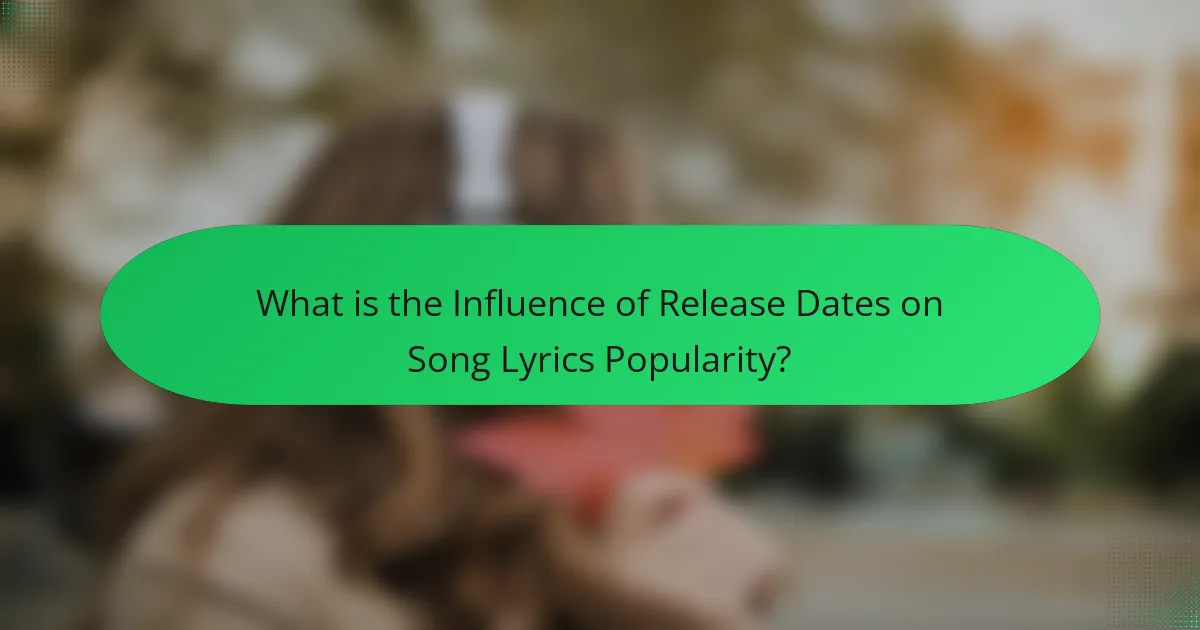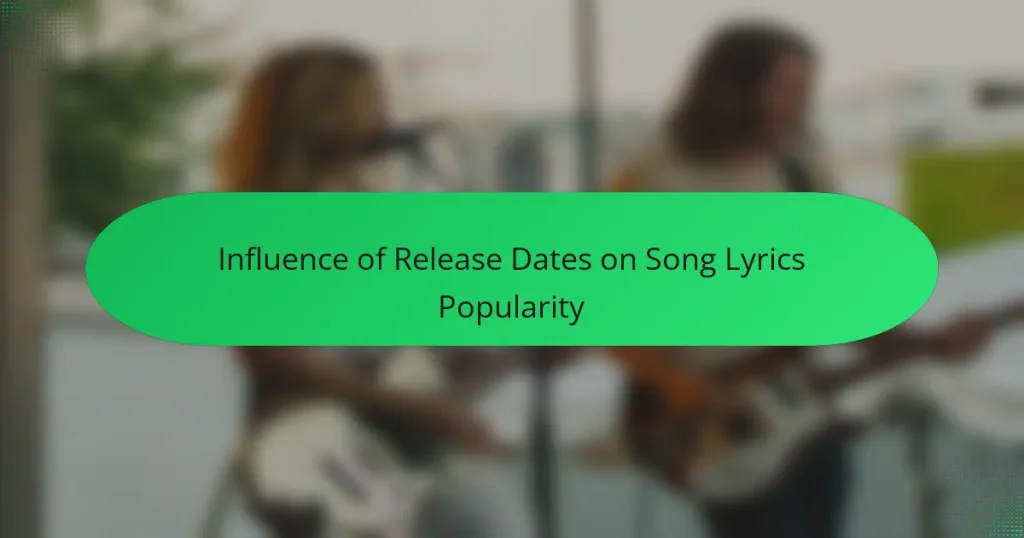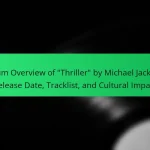Release dates are a critical factor influencing the popularity of song lyrics. The timing of a song’s release can significantly affect its visibility and listener engagement, with seasonal and event-based releases often attracting more attention. For instance, summer hits typically peak in popularity during June and July, while holiday-themed songs see a rise in the latter part of the year. Additionally, research indicates that songs launched on Fridays benefit from heightened streaming activity, making strategic release timing essential for maximizing lyrical popularity. This article explores how these dynamics impact the success of songs in the music industry.

What is the Influence of Release Dates on Song Lyrics Popularity?
Release dates significantly influence song lyrics popularity. Songs released during specific seasons or events often gain more attention. For example, summer hits typically dominate charts in June and July. Conversely, holiday-themed songs peak around the end of the year. Timing can align with cultural moments, enhancing listener engagement. Research shows that songs released on Fridays perform better due to increased streaming activity. Additionally, competition with other releases can affect a song’s visibility. Therefore, strategic release timing is crucial for maximizing lyrical popularity.
How do release dates affect the reception of song lyrics?
Release dates significantly affect the reception of song lyrics. The timing of a release can align with cultural events or social movements. For instance, songs released during political unrest often resonate more deeply with audiences. Historical examples include songs like “Fight the Power” by Public Enemy, which gained traction during the civil rights movement. Additionally, seasonal releases can influence how lyrics are perceived; summer hits often focus on themes of fun and freedom. Research shows that songs released during holidays tend to see increased engagement. Overall, the context provided by the release date shapes listener interpretation and emotional response to lyrics.
What role does timing play in the popularity of song lyrics?
Timing significantly influences the popularity of song lyrics. The release date can align with cultural events or trends, enhancing listener engagement. For example, songs released during holidays often see increased popularity due to thematic relevance. Additionally, songs that coincide with viral trends or social movements can gain traction quickly. Historical data shows that tracks released in summer months often perform better due to seasonal listening habits. Furthermore, strategic timing around major music events can amplify a song’s reach. Overall, timing is a critical factor that can determine a song’s success in the market.
How do seasonal trends impact song lyrics popularity?
Seasonal trends significantly impact song lyrics popularity by influencing listener emotions and preferences. During summer, upbeat and feel-good lyrics often gain traction. Songs with themes of love and adventure resonate more in warmer months. In contrast, winter often sees a rise in reflective and nostalgic lyrics. Holiday-themed songs become particularly popular during the festive season. Research indicates that songs released in alignment with seasonal events tend to perform better on charts. For example, Billboard data shows increased streams for holiday songs each December. Additionally, seasonal changes can affect radio playlists, further amplifying certain song themes.
Why are release dates strategically chosen by artists?
Release dates are strategically chosen by artists to maximize impact and engagement. Timing can align with cultural events, holidays, or trends to enhance visibility. For instance, releasing music during summer can capitalize on seasonal listening habits. Additionally, artists may avoid competition by selecting dates with fewer major releases. Research shows that songs released on Fridays tend to perform better due to increased weekend listening. Data from Billboard indicates that strategic release timing can significantly influence chart performance. Therefore, artists consider various factors to optimize their release dates for greater success.
What factors influence an artist’s choice of release date?
An artist’s choice of release date is influenced by various strategic factors. These include market trends, competition, and seasonal relevance. For instance, artists often aim to release music during peak listening times, such as summer or holiday seasons. Research shows that songs released in these periods tend to perform better on charts. Additionally, avoiding major artist releases can prevent overshadowing. Collaborations or events may also dictate timing for maximum exposure. Social media trends can further shape release strategies, ensuring alignment with audience engagement. Overall, careful planning around these factors is crucial for an artist’s success.
How do industry trends dictate release schedules?
Industry trends significantly influence release schedules by dictating optimal timing for market entry. Music labels analyze consumer behavior and seasonal patterns. For instance, summer months often see increased releases due to higher listener engagement. Additionally, trends in streaming data reveal peak times for specific genres. Historical data shows that releases aligned with major events, like holidays, tend to perform better. This strategic timing maximizes exposure and sales potential. Thus, industry trends serve as a guiding framework for planning release dates effectively.
What are the historical patterns in song releases and their popularity?
Historical patterns in song releases indicate that timing significantly affects popularity. Songs released during summer months often achieve higher chart positions. For example, Billboard data shows that many number one hits emerge in June and July. Conversely, releases in late fall or winter may struggle due to holiday distractions. The rise of digital streaming also shifted release strategies. Artists now often release songs on Fridays to maximize weekend listening. Historical trends reveal that songs aligned with cultural events or seasons tend to gain traction. For instance, holiday-themed songs frequently see spikes in popularity during their respective seasons. Overall, strategic release timing plays a crucial role in a song’s commercial success.
How have past release dates shaped the success of lyrics?
Past release dates significantly influence the success of lyrics. Timing can align songs with cultural events or trends. For instance, songs released during summer often become summer anthems. Historical events can also impact lyrical relevance. Songs released after major societal changes may resonate more deeply. Research shows that songs released during peak listening times see higher chart performance. For example, holiday-themed songs often perform well when released close to the holiday season. Additionally, the evolution of music consumption platforms affects how release dates shape success. Songs released on Fridays benefit from weekend listening habits. Thus, past release dates are crucial for maximizing lyrical impact and popularity.
What notable examples illustrate the impact of release timing?
Notable examples illustrating the impact of release timing include the song “Summer” by Calvin Harris, released in May 2014. The timing aligned with the onset of summer, contributing to its peak popularity during the season. Another example is “Christmas Tree” by Lady Gaga, released in December 2008. The holiday timing ensured its relevance during the festive season, enhancing its streaming and sales figures. Additionally, “Back to December” by Taylor Swift, released in October 2010, coincided with the fall season, resonating with listeners experiencing nostalgia. These examples demonstrate how strategic release dates can significantly influence a song’s popularity and reception in the market.
How does the release date correlate with lyrical themes?
The release date of a song often influences its lyrical themes. Songs released during specific seasons may reflect themes relevant to that time. For example, summer releases frequently feature upbeat and carefree lyrics. Conversely, songs released in winter may explore themes of nostalgia or introspection.
Cultural events and societal issues at the time of release can also shape lyrical content. For instance, songs released during political unrest may contain themes of protest or social commentary. Historical events often find reflection in music, as artists respond to their environment.
Research indicates that songs released during significant cultural moments tend to resonate more with listeners. The connection between the timing of a release and its lyrical themes can enhance a song’s relevance and popularity.
What themes are commonly associated with specific release periods?
Themes commonly associated with specific release periods include seasonal motifs, cultural events, and societal issues. Seasonal motifs often reflect the time of year. For instance, songs released in summer may celebrate love and freedom. Cultural events like holidays inspire themes of celebration or reflection. Songs released around Christmas typically focus on joy and family. Societal issues influence themes during significant events. For example, songs released during political movements often address activism and change. Historical context can also shape themes. Songs released during economic downturns may focus on struggle and resilience. These patterns demonstrate how release periods impact lyrical content and popularity.
How do current events influence lyrical content at the time of release?
Current events significantly influence lyrical content at the time of release. Artists often draw inspiration from social, political, and cultural happenings. This connection allows songs to resonate with listeners’ experiences. For example, during the COVID-19 pandemic, many artists addressed themes of isolation and resilience in their lyrics. Similarly, movements like Black Lives Matter have prompted songs that reflect social justice issues. The immediacy of current events can lead to timely releases that capture public sentiment. This relevance can enhance a song’s popularity and emotional impact. Therefore, lyrical content often mirrors the zeitgeist, making it relatable and poignant for audiences.
What strategies can artists use to maximize the popularity of their lyrics?
Artists can maximize the popularity of their lyrics by focusing on relatable themes. Lyrics that resonate with listeners tend to attract more attention. Incorporating current social issues can enhance relevance. Engaging storytelling within lyrics also captivates audiences. Collaborating with popular artists can expand reach and visibility. Utilizing social media for promotion increases exposure significantly. Releasing lyrics alongside visually appealing music videos can enhance audience engagement. Regularly interacting with fans fosters a loyal following and boosts popularity.
How can artists effectively choose a release date for maximum impact?
Artists can effectively choose a release date for maximum impact by analyzing market trends and audience behavior. Timing a release during peak listening periods, such as weekends or holidays, can increase visibility. Research shows that songs released on Fridays see higher streaming numbers. Additionally, avoiding competition from major artists can enhance an album’s chances of chart success. Artists should also consider seasonal themes that resonate with their music. Monitoring social media trends can provide insights into optimal timing. Overall, strategic planning around release dates can significantly boost a song’s popularity.
What promotional tactics enhance the visibility of song lyrics upon release?
Social media campaigns enhance the visibility of song lyrics upon release. Artists often use platforms like Instagram and Twitter to share snippets of lyrics. Engaging visuals or videos can attract attention and encourage sharing. Collaborations with influencers can further amplify reach. Lyric videos on YouTube provide an accessible way for fans to engage with the lyrics. Pre-release teasers build anticipation and drive interest. Email newsletters keep dedicated fans informed about new releases. Utilizing trending hashtags can increase discoverability in online conversations. These tactics collectively boost the visibility of song lyrics significantly.
The main entity of this article is the influence of release dates on song lyrics popularity. The article examines how strategic timing of song releases affects listener engagement and chart performance, highlighting the significance of seasonal trends, cultural events, and industry practices. It discusses the correlation between release dates and lyrical themes, providing historical examples and current trends that illustrate the impact of timing on a song’s success. Additionally, it outlines strategies artists can employ to maximize the popularity of their lyrics through effective release date selection and promotional tactics.


